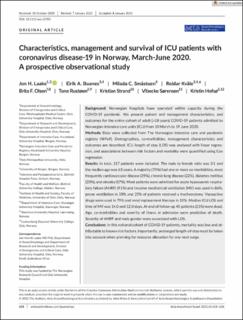| dc.contributor.author | Laake, Jon Henrik | |
| dc.contributor.author | Buanes, Eirik A. | |
| dc.contributor.author | Småstuen, Milada C. | |
| dc.contributor.author | Kvåle, Reidar | |
| dc.contributor.author | Olsen, Brita Fosser | |
| dc.contributor.author | Rustøen, Tone | |
| dc.contributor.author | Strand, Kristian | |
| dc.contributor.author | Sørensen, Vibecke | |
| dc.contributor.author | Hofsø, Kristin | |
| dc.date.accessioned | 2021-11-09T10:16:31Z | |
| dc.date.available | 2021-11-09T10:16:31Z | |
| dc.date.created | 2021-06-24T11:41:57Z | |
| dc.date.issued | 2021 | |
| dc.identifier.citation | Acta Anaesthesiologica Scandinavica. 2021, 65 (5), 618-628. | en_US |
| dc.identifier.issn | 0001-5172 | |
| dc.identifier.uri | https://hdl.handle.net/11250/2828640 | |
| dc.description.abstract | Background
Norwegian hospitals have operated within capacity during the COVID-19 pandemic. We present patient and management characteristics, and outcomes for the entire cohort of adult (>18 years) COVID-19 patients admitted to Norwegian intensive care units (ICU) from 10 March to 19 June 2020.
Methods
Data were collected from The Norwegian intensive care and pandemic registry (NIPaR). Demographics, co-morbidities, management characteristics and outcomes are described. ICU length of stay (LOS) was analysed with linear regression, and associations between risk factors and mortality were quantified using Cox regression.
Results
In total, 217 patients were included. The male to female ratio was 3:1 and the median age was 63 years. A majority (70%) had one or more co-morbidities, most frequently cardiovascular disease (39%), chronic lung disease (22%), diabetes mellitus (20%), and obesity (17%). Most patients were admitted for acute hypoxaemic respiratory failure (AHRF) (91%) and invasive mechanical ventilation (MV) was used in 86%, prone ventilation in 38% and 25% of patients received a tracheostomy. Vasoactive drugs were used in 79% and renal replacement therapy in 15%. Median ICU LOS and time of MV was 14.0 and 12.0 days. At end of follow-up 45 patients (21%) were dead. Age, co-morbidities and severity of illness at admission were predictive of death. Severity of AHRF and male gender were associated with LOS.
Conclusions
In this national cohort of COVID-19 patients, mortality was low and attributable to known risk factors. Importantly, prolonged length-of-stay must be taken into account when planning for resource allocation for any next surge. | en_US |
| dc.language.iso | eng | en_US |
| dc.rights | Attribution-NonCommercial-NoDerivatives 4.0 Internasjonal | * |
| dc.rights.uri | http://creativecommons.org/licenses/by-nc-nd/4.0/deed.no | * |
| dc.subject | Covid-19 | en_US |
| dc.subject | Intensivsykepleie | en_US |
| dc.title | Characteristics, management and survival of ICU patients with coronavirus disease-19 in Norway, March-June 2020. A prospective observational study | en_US |
| dc.type | Peer reviewed | en_US |
| dc.type | Journal article | en_US |
| dc.description.version | publishedVersion | en_US |
| dc.source.pagenumber | 618-628 | en_US |
| dc.source.volume | 65 | en_US |
| dc.source.journal | Acta Anaesthesiologica Scandinavica | en_US |
| dc.source.issue | 5 | en_US |
| dc.identifier.doi | 10.1111/aas.13785 | |
| dc.identifier.cristin | 1918125 | |
| cristin.ispublished | true | |
| cristin.fulltext | original | |
| cristin.qualitycode | 1 | |

